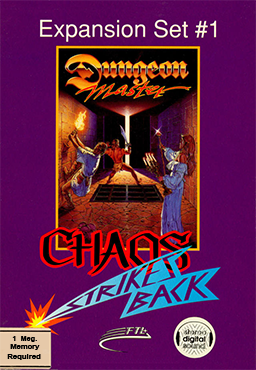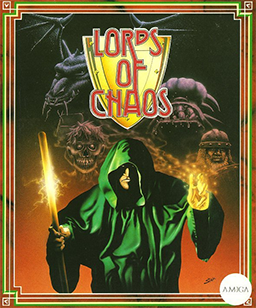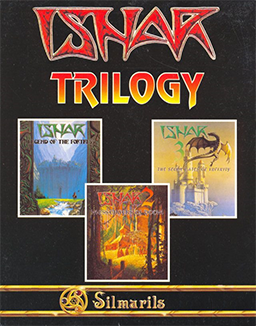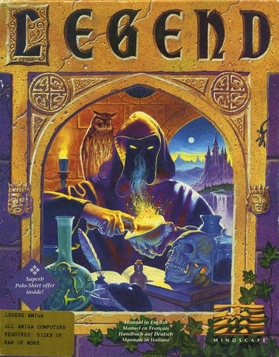
Bloodwych is a dungeon role-playing video game, a dungeon crawler, developed for the Amiga, Atari ST, MS-DOS, Amstrad CPC, Commodore 64, and ZX Spectrum. The box artwork is Chris Achilleos. The player is a champion of Trazere who, after recruiting up to three fellow champions, travels through dungeons and mazes fighting creatures along the way to find and destroy the evil Zendick, and banish the Lord of Entropy.

Curse of the Azure Bonds is a role-playing video game developed and published by Strategic Simulations in 1989. It is the second in a four-part series of Forgotten Realms Advanced Dungeons & Dragons Gold Box games, continuing the events of Pool of Radiance.

Gobliiins is a puzzle adventure video game series, consisting of five entries, released by Coktel Vision for the Amiga, Atari ST, DOS, Macintosh, iOS and Windows platforms. The first three titles were released in the early 1990s, the fourth in 2009, and fifth in 2023. The visual look of the series and its characters were created by French artist Pierre Gilhodes, whose style was used in another game from Coktel Vision: Woodruff and the Schnibble of Azimuth.

Chaos Strikes Back is an expansion and sequel to Dungeon Master, the earlier 3D role-playing video game. Chaos Strikes Back was released in 1989 and is also available on several platforms. It uses the same engine as Dungeon Master, with new graphics and a new, far more challenging, dungeon.

Silmarils was a French computer game software company founded in 1987 by Louis-Marie and André Rocques. It produced games for PC, Amiga, Amstrad CPC, Macintosh, Atari ST and Atari Falcon.

Lords of Chaos is a turn-based tactics tactical role-playing game published by Blade Software in 1990. It is the sequel to Chaos: The Battle of Wizards and an ancestor of the popular X-COM series of games, also written by Julian Gollop. In Lords of Chaos each player controls a wizard who can cast various magic spells. The spells have various effects, for example summoning other creatures, or damaging opposing creatures and wizards. The game can be played against a computer-controlled opponent or by up to four human players.

Laser Squad is a turn-based tactics video game, originally released for the ZX Spectrum and later for the Commodore 64, Amstrad CPC, MSX, Amiga, Sharp MZ-800 and Atari ST and PC computers between 1988 and 1992. It was designed by Julian Gollop and his team at Target Games and published by Blade Software, expanding on the ideas applied in their earlier Rebelstar series. Laser Squad originally came with five mission scenarios, with an expansion pack released for the 8-bit versions, containing a further two scenarios.
Simon the Sorcerer is a series of point-and-click adventure games created by British developer Adventure Soft. The series follows the adventures of an unwilling hero of the same name and has a strong fantasy setting similar to Sierra's King's Quest and Westwood's The Legend of Kyrandia series. The game varies in style, however, as it is more poised to be a parody of the fantasy genre than a member of the genre itself, with many renowned folklore characters appearing differently from what they are generally presumed to be.

Obitus is an action-adventure game developed and released by Psygnosis in early 1991 for Amiga, Atari ST and DOS. It was also ported to the Super Nintendo Entertainment System by Bullet-Proof Software. The game features both first-person dungeon crawling and side-scrolling gameplay with action-oriented combat and an emphasis on item acquisition. It is similar to games like Eye of the Beholder on Super Nintendo but without the RPG mechanics.

The Immortal is an isometric action-adventure game originally created by Will Harvey and released by Electronic Arts in 1990 for the Apple IIGS. It was soon ported to the Amiga, Atari ST, DOS, Nintendo Entertainment System, and Genesis. A wizard is attempting to find his mentor in a large and dangerous labyrinth. It has a high degree of graphic violence. In 2020, the NES port was re-released on the Nintendo Switch Online service, while the Genesis port was re-released on the Piko Collection Collection 1 cartridge for the Evercade.

Ishar is a series of three role-playing video games by Silmarils for IBM PC compatibles, Amiga, Atari ST, and Macintosh. They are preceded by Crystals of Arborea. The games are played in first-person perspective, with all but Crystals of Arborea allowing the player to direct a group of five characters, each with a selectable race, gender, and class.

Legend, also known as The Four Crystals of Trazere in the United States, is an isometric fantasy role-playing game released in 1992 for the Amiga, Atari ST, and DOS. It was developed by Pete James and Anthony Taglione for the then UK-based Mindscape, and published by The Software Toolworks. In the game, the player controls four adventurers on a quest to save the land of Trazere from an ancient, re-awakening evil. In 1993, Mindscape released a sequel, Worlds of Legend: Son of the Empire. The copyrights for both "Legend" and "Worlds of Legend" are currently owned by Ubisoft, who bought them from Mattel Interactive with the rest of the Mindscape library in 2001.

Gauntlet III: The Final Quest is a home computer game by U.S. Gold and Tengen it was released in 1991 for the Amiga, Atari ST, Commodore 64, ZX Spectrum, and Amstrad CPC. Besides the standard four main Gauntlet characters, Thor, Thyra, Merlin, and Questor, four new playable characters were available: Petras, a rock man; Dracolis, a lizard man; Blizzard, an ice man; and Neptune, a Merman. The game is viewed from an isometric perspective and the cooperative multiplayer mode supports two-players.

Ishar 3: The Seven Gates of Infinity is a 1994 role-playing video game developed and published by Silmarils. It is part of the Ishar series of games, and a sequel to Ishar 2: Messengers of Doom.

The Chaos Engine 2 is a top-down shooter video game, and sequel to The Chaos Engine, released for the Amiga in 1996 and developed by The Bitmap Brothers. A Sega Mega Drive version was planned but never released.

Ishar 2: Messengers of Doom is a 1993 role-playing video game developed and published by Silmarils for the Amiga, Atari ST, MS-DOS, Atari Falcon, and Macintosh home computers. It is the second entry in the Ishar trilogy.

Ishar: Legend of the Fortress is a 1992 role-playing video game developed and published by Silmarils for the Amiga, Atari ST, Macintosh, MS-DOS, and Atari Falcon home computers. It is the first entry in the Ishar trilogy.

Robinson's Requiem is a 1994 survival simulation video game developed and originally published by Silmarils exclusively in Europe for the Atari ST, Atari Falcon and Amiga. Taking place in the 22nd century where Earth and colonized planets are facing overpopulation, the game sees players assuming the role of Robinson officer Trepliev 1 from the Alien World Exploration department in his attempt to escape imprisonment from the fictional planet of Zarathustra alongside another AWE Robinson named Nina1, while facing several hostile creatures and dangers in order to survive.
ReadySoft was a Canadian video game developer and publisher and distributor founded in 1987 by David Foster, based in Ontario, Canada. Products include various emulators as well as home computer ports of Sullivan Bluth's Laser disc game series Dragon's Lair, Space Ace, and their sequels. As a publisher, they frequently handled North American release of games by French developer Silmarils.

Targhan is a side-scrolling hack and slash action-adventure game developed and published for MS-DOS, Amiga, and Atari ST by Silmarils and released in 1989. Color Dreams had announced plans for a Genesis port but it has not been released.


















